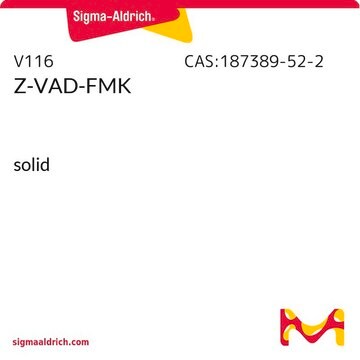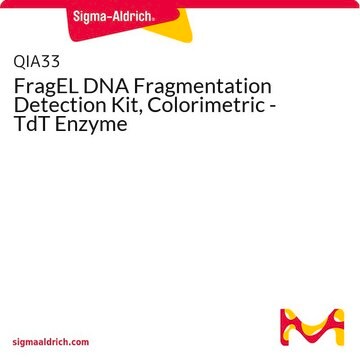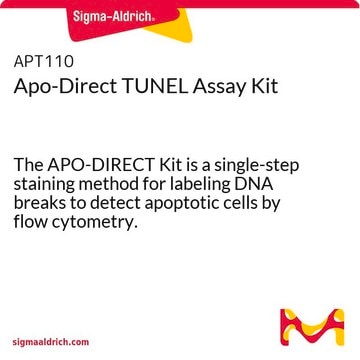11835246001
Roche
Apoptotic DNA-Ladder Kit
Synonyme(s) :
DNA ladder
About This Item
Produits recommandés
Utilisation
sufficient for ≤20 tests
Fabricant/nom de marque
Roche
Température de stockage
20-25°C
Description générale
The study of cell death involves characterizing mortality as apoptotic or necrotic. Apoptosis can be characterized by:
- Prelytic, non-random fragmentation of DNA (“ladder” pattern after agarose-gel electrophoresis)1
- Formation of membrane-bound vesicles (or “apoptotic bodies”)
- Cell shrinkage due to a concentration of cytoplasm
Similarly, necrosis (or physiological cell death) is characterized by
- Random digestion of DNA (DNA smear after agarose-gel electrophoresis)
- Swollen organelles and cells, resulting from loss of membrane integrity and cell lysis
- Postlytic DNA fragmentation
As these differences indicate, the classification of cell death can be accomplished through observing cell morphology, or less subjectively, by analyzing genomic DNA. Resolving the DNA on a gel provides a quick and documentable form of data to differentiate between apoptosis and necrosis.
Spécificité
Application
Conditionnement
Principe
Notes préparatoires
Preparation of Working Solutions
- Add 80 ml ethanol, analysis grade, to Washing Buffer
- Dissolve Positive Control (violet cap) in 400 μl Binding/Lysis Buffer and mix immediately.
- Incubate for 10 minutes at 15 to 25 °C.
EDTA solution (0.5 M)
Dissolve 18.6 g EDTA in 80 ml double dist. water and stir. Adjust pH 8.0 ± 0.1 with 1 M NaOH. EDTA solubilizes at alkaline pH only. After solubilization fill up to 100 ml with double dist. water.
TBE-Buffer
Dissolve 5.4 g Tris, 2.8 g Boric acid in 800 ml double dist. water and add 2 ml
of 0.5 M EDTA solution . Stir until dissolved, final pH 8.0 ± 0.1. Fill up to 1 liter with double dist. water.
Ethidium bromide stock solution
Dissolve 50 mg ethidium bromide in 5 ml double dist. water (ethidium bromide is a mutagen and potential carcinogen; gloves should be worn and care should be taken when handling ethidium bromide solutions).
Alternatively SYBR Green I Nucleic Acid Gel Stain can be used instead of Ethidium bromide.
Loading Buffer (10x)
Dissolve 0.1 g sodium dodecyl sulfate, 25 mg Bromophenol Blue in 7 ml double dist. water and add 3 ml glycerol
Storage conditions (working solution): The positive control can be used for 14 days after preparation, when storing the isolated control DNA at -15 to -25 °C.
Autres remarques
Informations légales
Composants de kit seuls
- Binding/Lysis Buffer
- Washing Buffer
- Elution Buffer
- Polypropylene Tubes, contain two layers of glass fiber fleece and can hold up to 700 μl sample volume
- Polypropylene Collection Tubes
- Control Apoptotic U937 Cells, lyophilized
Mention d'avertissement
Danger
Mentions de danger
Conseils de prudence
Classification des risques
Acute Tox. 4 Oral - Aquatic Chronic 3 - Eye Dam. 1 - Skin Irrit. 2
Code de la classe de stockage
12 - Non Combustible Liquids
Classe de danger pour l'eau (WGK)
WGK 2
Point d'éclair (°F)
does not flash
Point d'éclair (°C)
does not flash
Faites votre choix parmi les versions les plus récentes :
Déjà en possession de ce produit ?
Retrouvez la documentation relative aux produits que vous avez récemment achetés dans la Bibliothèque de documents.
Les clients ont également consulté
Articles
Cellular apoptosis assays to detect programmed cell death using Annexin V, Caspase and TUNEL DNA fragmentation assays.
Notre équipe de scientifiques dispose d'une expérience dans tous les secteurs de la recherche, notamment en sciences de la vie, science des matériaux, synthèse chimique, chromatographie, analyse et dans de nombreux autres domaines..
Contacter notre Service technique












